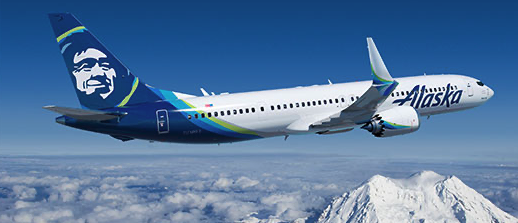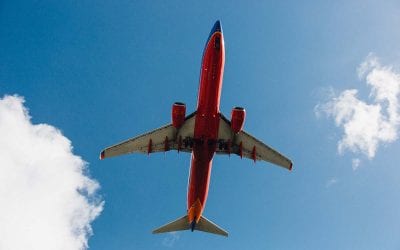We can learn much about surviving a rapid decompression accident by examining what happened to Alaska Airlines Flight 1282, when a door-plug blew out, leaving a huge hole in the fuselage. Everyone survived, mostly because each passenger was still wearing their seat belt.
 The National Transportation Safety Board (NTSB) investigation of what happened during the accident on Alaska Airlines Flight 1282 on Friday, January 5, is just beginning, but there is already much that we know and much that we can already learn to help us survive a rapid or explosive decompression accident.
The National Transportation Safety Board (NTSB) investigation of what happened during the accident on Alaska Airlines Flight 1282 on Friday, January 5, is just beginning, but there is already much that we know and much that we can already learn to help us survive a rapid or explosive decompression accident.
The Alaska Airlines flight was scheduled to fly from Portland International Airport in Oregon to Ontario International Airport in California on a Boeing 737 MAX 9 aircraft. There were 171 passengers on board the flight, along with 6 crew members, two pilots and four flight attendants.
All 177 people on board the flight survived, though some required medical attention.
The 737 MAX 9 used by Alaska Airlines has two door-plugs where other airlines have a mid-cabin emergency door on both sides of the plane. It’s because Alaska Airlines uses a less dense passenger configuration. While you can see the outlines of the door-plugs on the exterior of the plane, inside the cabin, there’s no hint that they’re there.
Approximately six minutes after takeoff from Portland, the port side door-plug blew out, leaving a hole in the fuselage the size of a full emergency door. That caused uncontrolled rapid decompression of the plane. The interior wall, window and insulation were torn out where the door-pug blew out. There was damage to seats next to the opening, but fortunately, no one was seated there.
Because the plane was still climbing after take-off, every passenger was still wearing their seat belt. It kept them alive.

At cruising altitude, with the seatbelt sign off, there’s little doubt that there would have been loss of life, as many passengers would have significantly loosened or disconnected their seatbelts, with some walking in the plane. Some of them would have been sucked out of the plane during the rapid decompression.
Passengers heard a boom and some saw the hole in the side of the plane. As the decompression sucked the air out of the plane, it sucked out AirPods, cellphones, shoes and clothes too.
Passengers said that they heard a boom and felt the plane jolt. Some saw the hole open in the side of the plane. The oxygen masks came down. The freezing outside air, likely around 0°F, rushed into the plane after decompression, rapidly dropping the cabin temperature. Decompression mist was seen. AirPods were ripped out of passengers’ ears and out the fuselage hole along with cellphones, shoes and other items. A mom screamed that her son’s shirt was ripped off, sucked away by the decompression. The sound in the plane was earsplitting from the thunderous jet engines heard through the hole in the cabin.
The pilots declared an emergency and descended to 10,000 feet where oxygen is no longer needed to safely breathe. About 20 minutes after takeoff, the plane safely landed back at Portland International.
We don’t yet know why the door-plug blew out of the 737 MAX 9 jetliner, but we can already learn from the accident.

courtesy Alaska Airlines
The problems of rapid decompression of an aircraft include deafening noise, an initial lack of oxygen, sub-freezing temperatures, debris strewn about the plane, dangerous cabin damage and prodigious decompression wind force, capable of lifting grown adults into the air and out of the plane.
Let’s examine the problems one by one.
Deafening noise:
If you’re lucky you’ll be in front of the damaged fuselage opening so the deafening sound of the engines will be diminished. Because you need to hear every command and announcement made by the flight crew, don’t put in earplugs or use noise cancelling earphones or headsets. Listen carefully to the flight crew. It could save your life.
Buddy-up if any oxygen masks fail. It won’t be long before the pilot descends to 10,000 feet, where you can safely breathe.
Lack of oxygen:
When the plane’s safety systems detect a cabin pressure loss, the emergency oxygen masks will automatically drop down. Put yours on immediately. If someone near you needs assistance putting their mask on, do it after donning yours. That includes children. You can’t help them if you can’t breathe. Breathe normally. The mask’s bag might not inflate, but that doesn’t mean it’s not working.
If some masks don’t work, share the working masks. You won’t need it too long, as the pilots will immediately start an emergency descent to 10,000 feet, where you can safely breathe without the mask.
Sub-freezing temperatures:
The higher you’re flying, the colder it is outside. As the plane descends to 10,000 feet, the temperature will warm. At 10,000 feet, the air temperature outside the plane will improve to around 10°F or so, still cold but no longer as cold as -70°F at cruising altitude.
Be careful what you wear in case of an aircraft accident. The right clothing can help you avoid serious injury.
The right clothing will help in an emergency. Wear long pants and long sleeved shirts made with natural fibers (synthetics or high synthetic content blends can be a fire hazard in a crash). I keep a jacket with me when flying in case the cabin is kept too cold and in case of emergencies.
Wear shoes or leather sneakers, never sandals, open toe footware, or flip-flops. Women should skip heels, as they’re awful in an emergency, particularly on escape slides. Sandals and heels aren’t safe when moving in a debris strewn cabin. Don’t wear loose or elaborate clothing. It can get snagged on obstacles, especially when there’s some damage.
Keep your belongings well stowed when not in use. In the event of rapid decompression you don’t want your laptop or tablet turning into a missile, flying through the cabin.
No one can hold on during rapid decompression. Wear your seat belt whenever seated in a plane and never hold babies and infants in your lap.
Prodigious wind decompression forces:
If rapid or explosive decompression occurs on your flight, wearing your seat belt whenever you’re seated will save your life. Unless I’m up to go to the lavatory, stretch a bit on a long flight at my seat or getting into my carry-on in the overhead bin, I stay seated on the plane and wear my seat belt at all times. If rapid aircraft decompression occurs, that will help prevent me from flying about, possibly out of the plane if the decompression hole is large and nearby. If decompression occurs while you’re up, get to your seat and don’t waste time trying to latch it. Just tie the two ends of your seat belt together temporarily.
If you’re traveling with an infant or small child, seat them in an appropriate safety seat, strapped into their own seat in the aircraft. During rapid decompression, if you’re near the opening, you won’t be able to hold your child safely in your lap, against the decompression forces. No one’s that strong.

READ ALSO:
Help! Hertz hit me with an $850 repair bill six months after I returned my rental car
Why follow these 4 guidebook tips when planning your trip
After many years working in corporate America as a chemical engineer, executive and eventually CFO of a multinational manufacturer, Ned founded a tech consulting company and later restarted NSL Photography, his photography business. Before entering the corporate world, Ned worked as a Public Health Engineer for the Philadelphia Department of Public Health. As a well known corporate, travel and wildlife photographer, Ned travels the world writing about travel and photography, as well as running photography workshops, seminars and photowalks. Visit Ned’s Photography Blog and Galleries.



